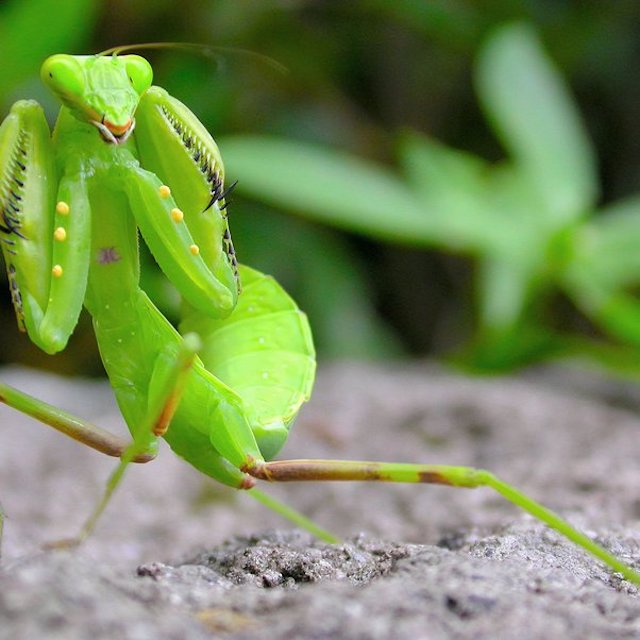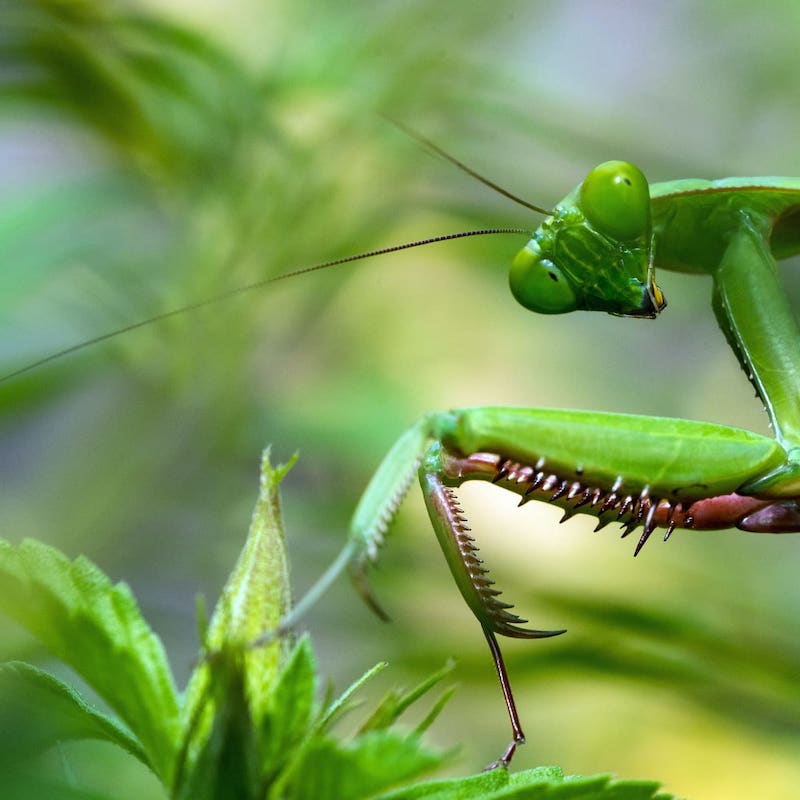Introduction to Praying Mantis and Walking Stick
The praying mantis and the walking stick are two remarkable insects that capture our fascination with their unique appearances and behaviors. Exploring the world of ‘praying mantis vs walking stick’ unravels a tale of adaptation and survival that has intrigued enthusiasts and scientists alike.
Praying mantises are known for their predatory skills and their characteristic ‘prayer-like’ stance. They boast a triangular head with bulging eyes and powerful, grasping front limbs, which they use to snatch unsuspecting prey. Their agility and camouflage make them formidable hunters in the insect world.
Walking sticks, or stick insects, on the other hand, are masters of disguise. Their long, slender bodies, resembling twigs or branches, provide the perfect camouflage from predators. This mimicry allows them to blend seamlessly into their surroundings, making them difficult to spot.
Both of these insects are not only fascinating in their own right but also serve as excellent examples of how different species adapt to their environments. Through this comparison, we’ll delve deep into the lives of these two insects, understand their differences and commonalities, and appreciate their unique roles in the ecosystem.
Join us as we embark on a journey to compare the praying mantis and walking stick across various aspects, including physical characteristics, habitats, diets, defense mechanisms, reproduction, ecological impact, and interesting facts. This showdown isn’t about declaring a winner; it’s about celebrating the diversity and adaptability of these incredible creatures.
Physical Characteristics Comparison
In the intriguing encounter between praying mantis vs walking stick, physical features play a key role. Let’s delve into the distinct characteristics that set these insects apart.
Praying Mantis Features
Praying mantises exhibit a set of unique features that equip them for life as predators. They have a striking, angular head that rotates 180 degrees, giving them a broad field of vision. This ability is crucial for tracking prey movements. A pair of large, compound eyes bulges from their head, enhancing their keen sight. Their elongated bodies, which can vary in color from green to brown, aid in blending with foliage. Praying mantises are known for their raptorial front legs, which they fold under their thorax in a prayer-like manner, waiting to seize prey with speed and precision.
Walking Stick Features
Walking sticks, in contrast, showcase characteristics that assist in their survival through concealment. They have long, thin bodies resembling twigs, with colors that mirror their plant-based habitats. Some species even bear leaf-like appendages for extra camouflage. Their slow, deliberate movements help maintain the illusion of being part of the surrounding vegetation. Unlike the mantis, walking sticks lack large eyes and prominent front limbs, focusing more on avoiding detection than on predation. Walking sticks can grow to impressive lengths, with some species stretching over a foot long, only adding to their stick-like disguise.
Habitat and Distribution
Understanding where each insect resides provides insight into their diverse lifestyles and survival strategies.
Where Praying Mantises Thrive
Praying mantises are versatile and can be found in various environments. They primarily inhabit warm, temperate, and tropical regions. These predators are common in gardens, meadows, and forests where foliage is abundant. They need environments rich in prey to support their carnivorous diet. Praying mantises also adapt well to different humidities, thriving in both arid and moist conditions.
Where Walking Sticks are Found
Walking sticks prefer habitats that offer ample vegetation for camouflage. They are generally located in tropical and subtropical regions but can also live in temperate zones. These insects are often found in forests and woodlands, clinging to branches and leaves. Some species reside in grasslands or scrub areas. Their presence is dictated by the availability of plants that enable them to conceal from predators and lay their eggs discreetly.
Dietary Habits and Predation
Dietary habits reveal much about an insect’s role in the ecosystem.
What Praying Mantises Eat
Praying mantises are skilled hunters. They feast on live insects like flies, moths, and beetles. Their diet can include larger prey such as frogs or birds. With their quick front legs, they grab and hold their victims firmly. They often consume their prey alive, starting with the head.
What Walking Sticks Consume
Walking sticks follow a simpler diet. They eat leaves from various plants, showing little interest in moving prey. This diet suits their slow-paced life and need for camouflage. They can strip entire branches bare when they feed in groups. Walking sticks often focus on the leaves of a single type of plant, which might influence their shape and color.
Defense Mechanisms and Camouflage
In the battleground of survival, both praying mantis and walking stick have evolved unique defense strategies. Priests pray, and sticks hide—one fights, the other shies away.
Praying Mantis Defense Tactics
Praying mantises rely on both stealth and skill. They adopt a stance—still, silent, waiting. Their colors merge with their surroundings—green or brown, leaf or bark. If threatened, they stand tall, spread their wings, and display eyespots to scare predators. Quick and fierce, they can strike an enemy with lightning speed. Surprising attackers, they use their spiny limbs to fight back.
Walking Stick Camouflage Strategies
Walking sticks are artists of disguise. They are masters at blending in. Their bodies mimic branches and leaves so well they are nearly invisible. They rock gently, like twigs in the breeze. When discovered, some drop to the ground, playing dead. Others can shed limbs to escape grasp—sacrificing a part to save the whole. Their camouflage is their shield, their stillness their sword.
Reproduction and Life Cycle
Reproduction and life cycle vary between the two insects, with unique attributes marking their journeys from egg to adult.
The Life Cycle of a Praying Mantis
The life of a praying mantis begins as a tiny egg laid in a protective case called an ootheca. The female usually attaches the ootheca to a plant, ensuring the next generation’s safety. When mantis nymphs hatch, they resemble miniature adults sans wings. These nymphs undergo several molts, shedding their exoskeletons as they grow. With each molt, they develop more, until their wings emerge fully formed. This process may take a few months to a year, varying by species and climate conditions.
The Life Cycle of a Walking Stick
Walking sticks also start their life in egg form. But instead of orderly cases, female walking sticks drop their eggs on the ground, mimicking seeds. After several months, the eggs hatch into nymphs. These nymphs look like small adults and will molt repeatedly. They increase in size but not in complexity as with the praying mantis. Walking sticks also have a variable development period, influenced by their environmental conditions. However, their focus remains on blending in, with changes in their form primarily enhancing their camouflage.
Ecological Impact and Importance
Both praying mantises and walking sticks play significant roles in their ecosystems. These insects contribute to biodiversity and the overall health of their habitats.
Praying Mantis in the Ecosystem
Praying mantises are not just predators; they’re crucial for balance. They help control pest populations, aiding in garden and crop health. By consuming insects that harm plants, mantises act as natural pest managers. This reduces the need for chemical pest control, which is good for the environment. They are also food for larger animals, fitting into the food chain. This makes them an integral part of ecosystem balance.
Walking Stick’s Role in Nature
Walking sticks aid in plant growth. They prune plants by eating leaves, which can stimulate new growth in moderation. Their selective feeding may also help with seed dispersal, as some nibbled leaves regrow stronger. However, in large numbers, they can defoliate plants. This highlights their dual role as both herbivores and potential pests. Walking sticks are also prey for various animals. This makes them a link in the food web, contributing to ecological complexity.
Interesting Behaviors and Facts
Both praying mantises and walking sticks exhibit fascinating behaviors that enhance their survival chances. Here are some noteworthy facts that highlight the distinctness of these two insects.
Praying Mantis: A Natural Head-Turner
Praying mantises have a flair for the dramatic. They can turn their heads nearly 180 degrees, a rare ability among insects. This gives them an edge in spotting potential prey or threats across a wide radius. They are also known for their ‘dance’ – a swaying motion that confuses prey and predators alike. Additionally, the praying mantis is one of the few insects capable of hearing ultrasound, which helps them evade bat predators.
Walking Stick: The Artful Dodger
Walking sticks exhibit a behavior known as ‘catalepsy’, where they freeze for long periods, blending with their environment perfectly. This makes spotting them a difficult task for both predators and humans. Some species of walking sticks even have the ability to regenerate lost limbs – a fascinating nod to their resilience. They also lay eggs that resemble seeds, which adds another layer to their camouflage game, fooling not just predators, but Mother Nature herself.
These behaviors and facts showcase the intricate world of ‘praying mantis vs walking stick’, where each insect has evolved in such a way that ensures their survival in the wild, depicting the wonder and complexity of nature.
Conclusion: The Role of Insects in Biodiversity
In the duel between praying mantis vs walking stick, we observe a larger picture. Insects play vital roles in biodiversity. They adapt to their settings and help ecosystems stay healthy. Praying mantises, as predators, keep pest populations in check. This action supports plant life and reduces the need for harmful chemicals. Walking sticks, though they may eat many leaves, also contribute. They prune plants, which can spur new growth. The dance of predator and prey maintains nature’s balance. Both insects serve as food for other creatures, linking the food chain. This battle of survival showcases nature’s beauty and balance. It’s clear. Whether hunters like the praying mantis or hiders like the walking stick, each insect is key. They all have roles that make our ecosystems diverse and robust. So, as we close this showdown, let’s appreciate these insects. They are small, but their impact on biodiversity is huge.


